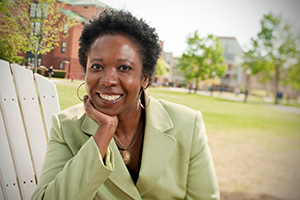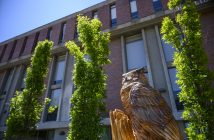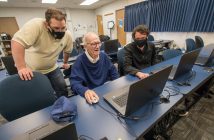Art professor supports inclusion, is driven to learn
“I could be a professional student,” Professor Christina Swaidan says. “I love learning.” No doubt about that. Swaidan’s academic resume is impressive.
A multitalented instructor who divides her academic prowess between the Art and Ethnic and Gender Studies departments, Swaidan’s higher education began with undergraduate work at the University of Notre Dame in South Bend, Ind., and a bachelor’s degree from Mt. Holyoke College in South Hadley.
Swaidan then earned a master’s in art history at the University of Mississippi; a master’s in educational leadership at St. Joseph’s University in Hartford, Conn.; and, most recently, a master’s and doctorate of education at the University of Hartford.
“I am wondering about going to law school,” she says, smiling.
In addition to teaching, Swaidan is the chair of Sankofa, an organization that supports diversity on the Westfield State campus. And along with her love of learning, she has brought to the campus a passion for art and history and a focus on the importance of inclusion and social justice.
Swaidan calls herself a “big picture professor.”
And that “big picture” includes encouraging University staff and faculty to continue to embrace and value diversity and inclusion.
All members of Sankofa honor the spirit, vision and ideals of the group by actively embracing a commitment to the expansion of the spirit of global diversity and multicultural principles.
Sankofa supports scholarships for students to study abroad, assists in the recruitment and admission of historically under-represented students, faculty and staff, and encourages campus-wide activities that promote diversity.
“We also have a Kente Stoling ceremony for graduating students, whom we call ‘Sankofa Scholars,’ who have been nominated by faculty and staff, called ‘Sankofa Sages,’ for their commitment to diversity,” explains Swaidan. “It is not just about the diversity of color.”
Sankofa’s logo of a mythic bird flying forward, but looking to the past and carrying an egg (symbolizing the future) best expresses Swaidan’s outlook on life.
She brings the past to students so that they may make the most of their future.
“I love Westfield State and the students I get to work with.” Swaidan says. “Every day is an adventure, a learning experience. I truly hope I am living the Sankofa life.”
Swaidan, a Worcester native, is the youngest of seven children. Her parents moved north from Brookhaven, Miss., before she was born.
“My siblings grew up during segregated times – classrooms were segregated. My grandmother cooked for a wealthy white family,” she says.
Her father believed that his children would have more opportunity in the North, but after she was grown, Swaidan surprised her family when she announced her decision to return and earn a graduate degree at the University of Mississippi, known as “Ole Miss.”
“I went back to Mississippi to see what it was like,” she says. “I had grown up listening to my father tell horror stories of cruel racism and horrid treatment in the South. He made it clear to all of us that he would never return to Brookhaven ‘unless I’m in a pine box,’ ” she recalls.
Swaidan’s experience in Mississippi was very different.
“I loved the south,” she says. “It was nothing like what I’d heard. There was racism, but the people were very honest about their feelings. There was no ‘soft’ racism – when people opened their home to you, you felt their sincerity.”
And, there was real diversity at the University of Mississippi.
“I met my husband, who is middle eastern, at Ole Miss,” she adds. She also discovered her love of art history. “I have absolutely no artistic ability, but I am completely enthralled by the cultural and historical underpinnings of art.”
Westfield State benefitted from Swaidan’s own personal diversity when she signed on as an adjunct art faculty member in 2005. Coming from teaching Latin and history at the high school level in South Hadley, Swaidan had the opportunity to teach art history – her first love.
“I am excited by the type of courses I get to teach here,” she says. “I especially love teaching Afro-American art, which I was introduced to at Ole Miss. I approach its study from a historical perspective, and then we look at their art.”
Often, what the students see in the art is the polar opposite of what the media has portrayed. “I like to think of myself as a social justice educator, and art is my vehicle,” Swaidan says.
Swaidan is more interested in exploring the history and meaning of art than having students memorize titles, dates and artists.
She thinks students are apprehensive that, “I will beat them over the head with racism, but I want to have an honest conversation about the history of racism as portrayed in art,” she says. “I love taking students of color and giving them their history. I get to pay it forward. I got it at Ole Miss, and now I can give it to my students at Westfield State.”




